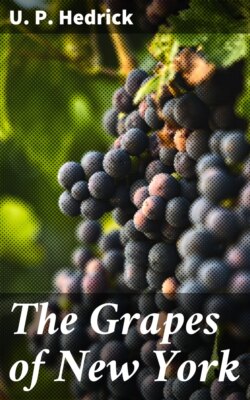Читать книгу The Grapes of New York - U. P. Hedrick - Страница 50
На сайте Литреса книга снята с продажи.
19. VITIS BICOLOR Le Conte.[148]
ОглавлениеTable of Contents
1. Le Conte, Proc. Phil. Acad. Nat. Sci., 6:272. 1853. V. aestivalis (Darlington). 2. Ib., U. S. Pat. Off. Rpt., 1857:230. Two-colored-leaved vine. 3. Munson, Soc. Prom. Ag. Sci. Rpt., 1887:59. V. Argentifolia; Blue grape. 4. An. Hort., 1889:101. 5. Munson, Gar. and For., 3:474. 1890. 6. Munson, U. S. D. A. Pom. Bul., 3:12. 1890. 7. Ib., Am. Gard., 12:585. 1891. Blue grape; Northern Summer grape. 8. Ib., Mich. Hort. Soc. Rpt., 1893:116. Blue grape; Northern aestivalis. 9. Bailey, Gray’s Syn. Fl., 1:428. 1897. Blue grape; Northern Summer grape. 10. Britton and Brown, 2:409. 1897. Blue grape; Winter grape; V. aestivalis, var. bicolor. 11. Munson, Tex. Sta. Bul., 56:231, 234, 240, 266. 1900. Blue grape. 12. Viala and Ravaz, Am. Vines, 1903:42, 59.
Vine vigorous, climbing; shoots cylindrical or slightly angled, with rather long internodes, generally perfectly glabrous, usually showing much blue bloom, sometimes spiny at base; diaphragms medium to thick; tendrils intermittent, long, usually bifid. Leaves with short, broad stipules; leaf-blade medium to very large; roundish-cordate, usually three-, sometimes on older growth shallowly five-lobed, rarely entire; petiolar sinus variable in depth, usually rather narrow; margin irregularly dentate; teeth acuminate; glabrous above, usually glabrous below and showing much blue bloom which sometimes disappears late in the season; young leaves sometimes slightly pubescent; petioles very long. Cluster of medium size, compact, usually simple; peduncle long. Berries small to medium, black with much blue bloom, rather acid but pleasant tasting when ripe. Seeds small, plump, broadly oval, very short beak; chalaza oval, raised, distinct; raphe distinct, showing as a cord-like ridge.
Bicolor is readily distinguished from Aestivalis by the absence of the reddish pubescence, and by the bloom on the under side of the leaves and is distinguished from the glaucous form of Lincecumii by the smaller fruit and seeds. The species blooms slightly later than Aestivalis and Lincecumii. It was named and described by Le Conte in 1853 and has been generally recognized as a distinct species by later botanists.
The habitat of Bicolor is to the north of that of Aestivalis, occupying the northeastern, whereas Aestivalis occupies the southeastern quarter of the United States. Like Aestivalis it is not confined to streams and river-banks but frequently grows on higher land also. It is found in north Missouri, Illinois, southwestern Wisconsin, Indiana, southern Michigan, Ohio, Kentucky, Pennsylvania, New York, southwestern Ontario, New Jersey and Maryland, and is by some botanists reported as far south as western North Carolina and west Tennessee.
The horticultural characters of Bicolor are much the same as those of Aestivalis. About the only points of difference are that it is much hardier (some of the Wisconsin vines stand a temperature as low as 20 degrees below zero); it is said to be slightly less resistant to mildew and more resistant to phylloxera. Like Aestivalis, Bicolor does not thrive on limy soils and it is difficult to propagate from cuttings. The horticultural possibilities of Bicolor are probably much the same as those of Aestivalis, though many believe it to be more promising for the North. It is as yet cultivated but little. Its chief defect for domestication is the small size of the fruit.
